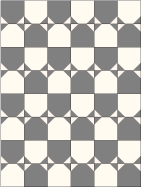Now that most of us have access to the internet, there’s a ton of good information out there about tessellations, so I’m not going to repeat it here. Rather, here are just a couple of examples and then some references you can use on the internet or get at a book store. With regard to the printed material, I have great luck finding used books to order online, mostly through AbeBooks.
The book I used most in learning about tessellations is Introduction to Tessellations by Dale Seymour and Jill Britton. It’s an old book, but math doesn’t change much and it should be available second hand. The take-home from this book is that tessellations are easier to design if you use graph paper of various kinds to guide your drawing. Options include regular graph paper with squares, dot paper, and triangle paper, as well as paper pre-printed with hexagons. If you check the internet, you can find places to print any of these, or there are samples in the back of the book for you to reproduce. The links above go to places that allow you to print various dot or triangle papers, but full disclosure: I haven’t tried them, since I have the book!
Another common way to make tessellations is to start with a piece of paper, cut a hunk out of it, and move the hunk to another edge. There are many variations on this, and I suggest you get some index cards and just go for it.
Here are some tessellations I have made to illustrate various possibilities.



It’s also possible to cut off a piece, move it to another location on the block, and then rotate it. At this point things become much more complex, and lead to the kind of tessellations that make almost anybody’s head spin! Luckily, there is an excellent step-by-step tutorial on how to do that at http://mathengaged.org/resources/activities/art-projects/tessellations/.
For a detailed lesson on how to make more complex tessellations (more like M. C. Escher), look at artist Juliana Kunstler’s website.
And here are a few of the many books available about tessellations:
Introduction to Tessellations by Dale Seymour and Jill Britton. This one is practical and relatively easy to understand.
Designing Tessellations by Jinny Beyer. This book goes into a lot of detail on how to make complex tessellations, but is easy to understand despite this. She has some beautiful examples of tessellated quilt patterns.
Tessellation Quilts by Christine Porter
For those in the Greensboro MQG, I hope you will design some tessellations and bring them for show-and-share in April! See you there!
Please note: As always, the links in this post are provided for your convenience only; they are not affiliate links that pay me if you click on them.



















